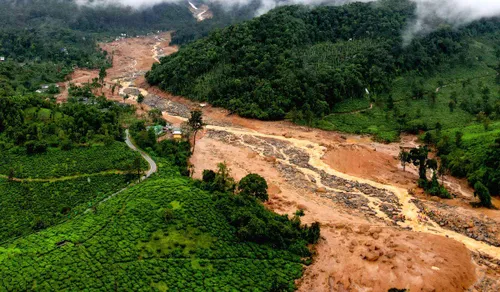Continues for Missing
The devastating landslide in Wayanad, Kerala, has prompted a significant search and rescue operation as authorities and teams continue to search for those missing. The landslide, triggered by heavy rainfall and adverse weather conditions, has caused substantial damage and led to a tragic loss of life. The ongoing search efforts are critical in locating and rescuing individuals affected by the disaster.
Table of Contents
Overview of the Landslide
The landslide occurred in the Wayanad district, a region known for its hilly terrain and vulnerability to landslides, especially during the monsoon season. The intense rainfall in recent days has saturated the soil, increasing the risk of landslides in the area.
1. Scale of the Disaster: The landslide struck with significant force, affecting several communities and infrastructure in the region. Reports indicate that homes, roads, and other structures have been buried under debris, exacerbating the challenges faced by rescue teams.
2. Immediate Impact: The immediate impact of the landslide has been severe, with multiple casualties reported and many residents displaced. Emergency services have been working tirelessly to provide assistance to those affected and to begin the search for missing individuals.
Ongoing Search and Rescue Efforts
The search and rescue operation is being coordinated by local authorities, disaster response teams, and various organizations. The operation involves several key components:
1. Deployment of Resources: Search and rescue teams, including personnel from the National Disaster Response Force (NDRF), state police, and local volunteers, have been deployed to the affected areas. Specialized equipment, including excavators, sniffer dogs, and drones, is being used to aid in locating missing persons.
2. Challenges Faced: The search efforts are hampered by the challenging terrain, continuous rainfall, and unstable ground conditions. The safety of rescue teams is a priority, and operations are being conducted with caution to avoid further risks.
3. Coordination and Communication: Effective coordination among various agencies and clear communication are essential for the success of the rescue operation. Authorities are working to ensure that information is disseminated promptly and that resources are allocated efficiently.
Community and Government Response
The response to the landslide has seen strong support from both the government and the community:
1. Government Support: The Kerala state government, along with the central government, has mobilized resources and provided support to the affected areas. Financial aid, relief materials, and medical assistance are being dispatched to help those in need.
2. Community Efforts: Local residents and community organizations have rallied to support the rescue efforts. Volunteers are assisting in the search operations and providing aid to displaced families.
3. Relief Measures: Relief camps have been set up to provide shelter and basic necessities to those who have been displaced by the landslide. Health and sanitation services are being provided to prevent the outbreak of diseases in the affected areas.
Long-Term Considerations
The Wayanad landslide highlights several long-term considerations for disaster management and community resilience:
1. Infrastructure Improvements: The disaster underscores the need for improved infrastructure and drainage systems to mitigate the impact of landslides and other natural disasters. Investment in infrastructure and maintenance is crucial for reducing vulnerability.
2. Disaster Preparedness: Strengthening disaster preparedness and response systems is essential for managing future incidents. Training, early warning systems, and community awareness programs can enhance resilience and readiness.
3. Environmental Management: Addressing environmental factors, such as deforestation and land use changes, is important for reducing the risk of landslides. Sustainable land management practices can help mitigate the impact of heavy rainfall and other natural hazards.
Conclusion
The search for missing individuals following the Wayanad landslide continues amid challenging conditions. The dedication of search and rescue teams, along with support from the government and community, is crucial in addressing the immediate needs of those affected and in locating those who remain missing.
As the situation evolves, efforts will focus on providing relief, addressing long-term recovery needs, and implementing measures to reduce the risk of future disasters. The landslide serves as a reminder of the importance of disaster preparedness, infrastructure resilience, and community support in managing the impacts of natural calamities.








